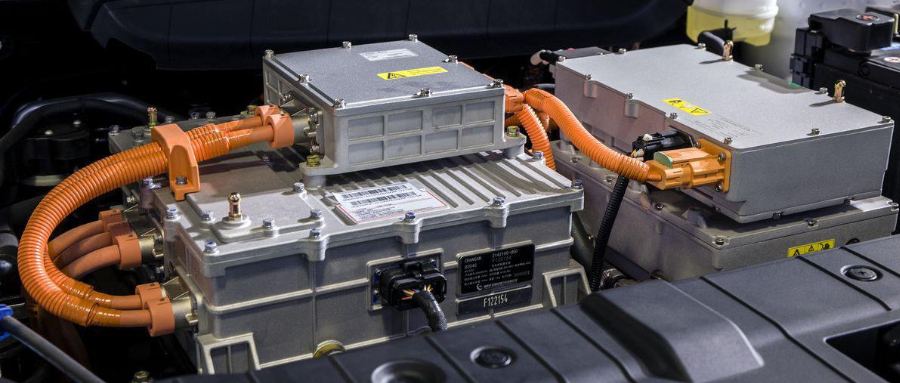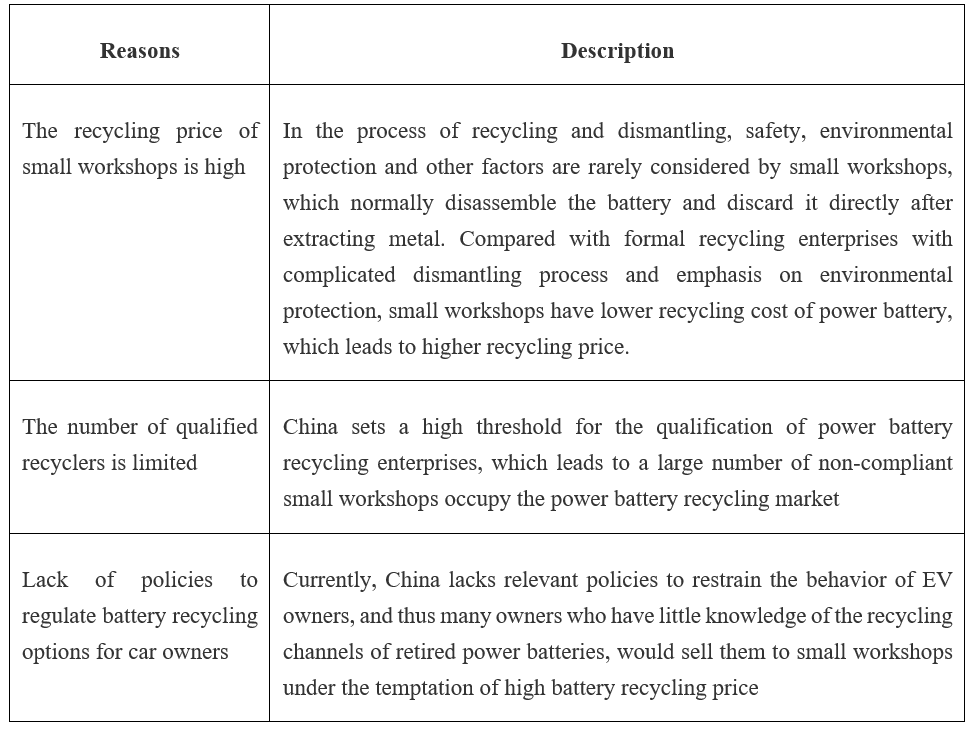

To achieve global carbon neutrality, countries have used the promotion of EVs as the main policy response to reduce road transportation emissions. With the development of the EV battery technology and its reduced manufacturing costs, the future EV registration is expected to grow continuously, making the disposal of waste batteries a huge challenge. This article will briefly review the current status and challenges of EV waste battery management in China, and will take the EU and South Korea as examples to explore what effective EV battery management policies can be utilized by China.
EV waste battery management in China
In 2015, China's new energy vehicle showed explosive growth, with the sales volume reaching 330,000 units, which is a 3.4 times growth year-on-year [1]. Assuming that the retirement of EV battery is generally 5 to 20 years [2], China is currently in the first peak of EV battery retirement. How to deal with the decommissioned batteries has become an imminent problem for the developmet of China's new energy vehicle industry.
According to the "Development of the Energy Efficient and New Energy Vehicle Industry Plan (2012-2020)" released in 2012, China currently adopts the management method of "first echelon utilization and then recyclable usage" for the recycling of retired batteries. The former is to disassemble and recombine the battery whose capacity attenuates to about 80% of original, and apply it to standby power supply of communication base station and energy storage of power system and so on, in areas where the requirement for battery energy density is low; the latter is to extract cobalt, nickel and other expensive metal elements from scrapped batteries and use them in secondary battery production to recycle its raw material. In order to ensure battery recycling, the Ministry of Industry and Information Technology issued the "Interim Measures for The Management of Battery Recycling and Utilization of New Energy Vehicles" in 2018, requiring that "NEV (New Energy Vehicle) makers be responsible for a battery's whole life cycle by building an aftermarket network to recycle used batteries" [3]. In August 2021, the "Management Measures for Echelon Utilization of Batteries of New Energy Vehicles" was issued to encourage echelon utilization enterprises to cooperate with manufacturers producing new energy vehicles and batteries, strengthen information sharing, and efficiently recycle discarded batteries for echelon utilization [4].
Waste battery management challenges for EVs in China
In order to standardize the battery recycling market, the Ministry of Industry and Information Technology has given a list of "Industry Standard Conditions for Comprehensive Utilization of Waste Batteries for New Energy Vehicles". By November 2021, a total of 27 enterprises in China have been on the list. According to the data of China Automotive Technology and Research Center, the cumulative decommission of batteries in China in 2020 is about 200,000 tons [5]. However, due to various reasons [6], most of the batteries are currently channeled into non-compliant small workshops for recycling (Table 1).
Table 1. The reasons why batteries flow into informal recycling channels in China

In general, there are many problems in battery recycling in China. Formal recycling enterprises invest more in environmental protection and safety performance, resulting in high recycling operation costs, which means that they cannot compete with informal small workshops and are in a disadvantagous market position.
What policies can be learned from the EU and South Korea
There are great safety concerns and environmental hazards in the process of power battery recycling and dismantling. If China does not introduce particular regulatory policies, a large number of small workshops will still emerge in the battery recycling market. The EU published "New Batteries Regulation" in December 2020, which separated power batteries from industrial batteries and regulated them as a separate category, from which China can also draw lessons to introduce finer management and supervision policies for power batteries in line with China's challenges, while cracking down on illegal recycling.
In addition, due to China's current lack of transparency in power battery information, the recycling of retired batteries is hindered, and because of the lack of accurate data to prove the value of these batteries, recycling enterprises can only analyze their value through post use performance, which leads to higher recycling costs. In fact, China issued the "Implementation Plan of Extended Manufacturer Responsibility Regulation" as early as 2016, which required that "electric vehicle and power battery manufacturing enterprises shall be responsible for establishing waste battery recycling network, and power battery manufacturing enterprises shall code their products and establish full life cycle traceability system" [7]. However, due to the lack of mandatory regulatory policies, it may find problems such as incomplete reporting of relevant information and difficulty in tracing the source. "New Batteries Regulation" [8] of the EU requires that power batteries must carry two-dimensional code labels to access basic battery information (such as manufacturer information, manufacturing date, chemical composition, etc.) and capacity information. Besides, the regulation also requires EV batteries on the market to have an electronic record, known as a battery passport, to facilitate recycling companies’ better understanding about key parameters like the remaining battery capacity, and achieve large-scale reuse of power batteries.
As mentioned above, EV owners in China are not clear about the recycling channels for retired batteries. In contrast, according to the regulations of the Ministry of Environment of South Korea, from December 2018, when an EV is scrapped, the owner who has received an EV subsidy must return the retired batteries to the municipality where he/she was subsided, and the Automobile Recycling Association will recycle them afterwards [9]. In this way, China can introduce relevant government regulations to flow retired batteries into official recycling channels.
Conclusion
In 2020, 1.367 million new energy automobiles were sold in China, and the market penetration rate increased from 0.1% in 2012 to 5.4% [10]. As the market of new energy automobile continues to expand in the future, the number of waste power batteries in China will also continue to surge, making the development of efficient retired power battery recycling management system a difficult challenge at hand. In the 14th Five-year Circular Economy Development Plan released by the National Development and Reform Commission last year, it was proposed to formulate a life-cycle management plan for automobiles, and build an information interaction system for the life-cycle of automobiles, covering automobile manufacturers and recycling enterprises [11]. While the Chinese government is gradually standardizing and improving power battery recycling policies, car companies also need to reconsider power battery recycling, such as taking battery recycling into consideration in the early stage of product planning.
Note:
[1] 中汽协:2015年新能源汽车销量33万辆,链接:https://www.sohu.com/a/54491110_118021
[2] Oeko-Institutet al. (2021). Emerging waste streams – Challenges and opportunities, p32, Link: https://www.oeko.de/en/publications/p-details/emerging-waste-streams-challenges-and-opportunities
[3] 关于印发《新能源汽车动力蓄电池回收利用管理暂行办法》的通知,工信部,链接:http://www.gov.cn/xinwen/2018-02/26/content_5268875.htm
[4] 五部门关于印发《新能源汽车动力蓄电池梯次利用管理办法》的通知,工信部等五部门,链接:http://www.gov.cn/zhengce/zhengceku/2021-08/28/content_5633897.htm
[5] 苑歆垣,汽车回收走出迷途,Industry&City(2021年9月)
[6] 王佳,黄秀荣,废旧动力电池的危害与回收,《生态经济》第37卷第12期(2012年12月)
[7] 国务院办公厅关于印发生产者责任延伸制度推行方案的通知,国务院,链接:http://www.gov.cn/zhengce/content/2017-01/03/content_5156043.htm
[8] Proposal for a REGULATION OF THE EUROPEAN PARLIAMENT AND OF THE COUNCIL concerning batteries and waste batteries, European Commission, Link: https://eur-lex.europa.eu/legal-content/EN/TXT/?uri=CELEX%3A52020PC0798
[9] Where do EV batteries go when they die?, Korea Herald, Link: http://www.koreaherald.com/view.php?ud=20200505000209
[10] 《中国汽车产业发展年报2021》,工信部装备工业发展中心,链接:http://www.miit-eidc.org.cn/module/download/downfile.jsp?classid=0&filename=ab5936358eb244bf96b63fe818f1680e.pdf
[11] 国家发展改革委关于印发“十四五”循环经济发展规划的通知,发改委,链接:http://www.gov.cn/zhengce/zhengceku/2021-07/07/content_5623077.htm
Author:Yuan Yating
Translation: Chen Shikai
Proofread: Pan Yiren
This article is an original article of the Rock Environment and Energy Institute. Please contact us to obtain the appropriate authorization to reprint. For cooperation and authorization, please send an email to: liying@reei.org.cn
* This is the translation of an article in Chinese. Should there be any inconsistency between Chinese and English version, the Chinese version shall prevail.




